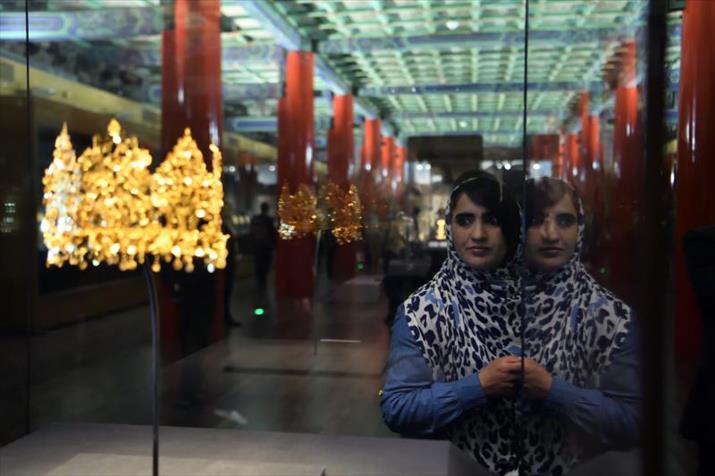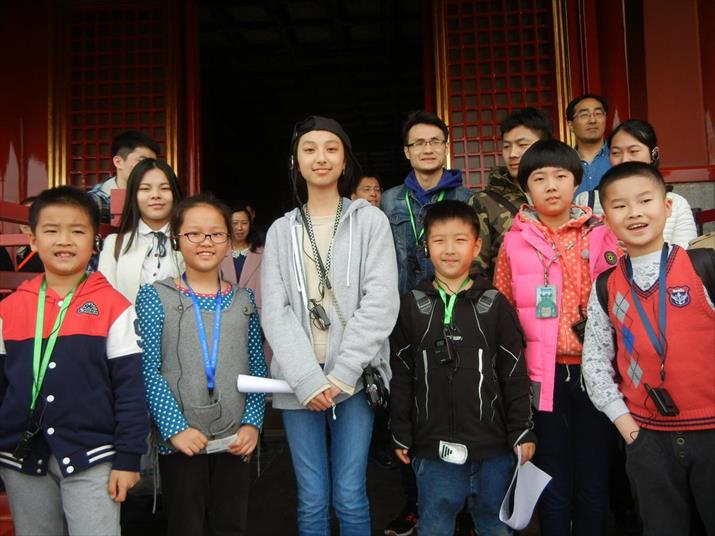| Lifestyle |
| Sharing Legacies | |
| An exhibition of Afghan treasures in Beijing continues the cultural exchange along the ancient Silk Road | |
|
|
 A woman appreciates a golden crown at the exhibition Afghanistan: Treasures From the National Museum, Kabul at the Palace Museum in Beijing on March 17 (XINHUA)
While working as a curator after majoring in contemporary art, Pu Hong felt something was missing from museums—people. "I felt there was a big question mark about the function of museums," the 30-year-old said. "I saw several museums hosting exhibitions that stayed on for two to three months, yet the number of visitors was sparse because there was no one to spread information about these exhibitions or tell visitors the stories behind the exhibits." So two years ago, Pu started his culture company in Beijing, Xin Yang Sheng Huo, which means "life of fresh air," to step into the breach. The start-up's work is to provide public education for families, with a focus on schoolchildren. "The aim is to eventually get every family to spend at least one day a month in a museum and to introduce them to 1,000 masterpieces in one year," he explained. "People in China want their children to have a good education. A museum is a great place for kids to gain knowledge." Pu's company covers four significant museums in the capital—the Palace Museum, a year-round tourist attraction due to its past avatar as the Forbidden City, the abode of China's emperors for more than 400 years; the National Museum of China, a repository of art housed in one of the "10 great constructions" undertaken to celebrate the 10th anniversary of the founding of the People's Republic of China; the Capital Museum; and the Tsinghua University Art Museum.  Pu Hong (second row, third right), founder of the Beijing-based child education company Xin Yang Sheng Huo, with his entourage at the Palace Museum on April 9 (SUDESHNA SARKAR)
A journey of rediscovery As summer made its tentative appearance in Beijing, Pu led a group of nine children, aged between 6 and 11 years, to the Palace Museum to see an exhibition at the Meridian Gate, called Afghanistan: Treasures From the National Museum, Kabul. The itinerant exhibition, with over 200 objects including gold jewelry, intricate ivory carvings and exquisite bronze items, arrived in Beijing from South Korea in March and is scheduled to move to Shanghai after June 17, where it will be hosted by the Shanghai Museum. "This is a matchless exhibition of very exquisite and priceless Afghan artifacts, some of which date back 4,000 years," Janan Mosazai, Afghan Ambassador to China, said. "It offers many beautiful glimpses into many eras of Afghanistan—different civilizations, cultures and influences that we have received from different countries and societies around us and that we have imparted to different societies and countries from Afghanistan. It illustrates our claim that Afghanistan is the cradle and meeting point of different world civilizations." Behind her glasses, Duan Jiaming's eyes gleamed in excitement. "I saw a bronze mirror at the exhibition which was from the Western Han Dynasty (206 B.C.- A.D. 25) in China," she said in a rush. A 6-year-old boy, who was also part of Pu's culture study entourage, had something to add to the conversation about cultural interactions. "I found a piece of gold with a Chinese dragon carved on it," he said. "Near it, I also saw a gold coin from India." Eleven-year-old Li Hongjin had more to impart. She had heard Afghanistan was part of the ancient Silk Road routes. With more countries joining in the Silk Road Economic Belt and 21st-Century Maritime Silk Road Initiative, China's time-honored links with Afghanistan look set to be revived. A unique fusion Mosazai said some of the individual items at the exhibition have very prominent influences from different civilizations—Greek, Roman, Indian and Chinese as well as Buddhist and Islamic—tempered by a local Afghan influence that made them "extraordinarily unique." "It is only in Afghanistan that you find such meeting of different cultures, and that's why we believe [the exhibition] is a very beautiful example of what we have to offer, which is heritage and culture," he said. The works on display are from four archaeological sites in Afghanistan: Tepe Fullol, a Bronze Age site; Tillya Tepe, famed for its burial mounds; the Greco-Bactrian city of Ai Khanum; and Begram, one of the most important archaeological sites in Afghanistan, whose excavated relics date back to the second century B.C. Begram has a special connection to the ancient Silk Road. "The term 'Silk Road' derives from the popularity of silk (produced solely by China) as a commodity in the Roman Empire," the preface to the exhibits from Begram says. "Afghanistan was central to this network of trade routes that crossed Central Asia, linking China and India with Greek and Roman settlements in the west and also with Egypt." In Begram, archaeologists discovered two rooms, sealed over 2,000 years ago, crammed with artifacts from different places connected by the trade routes of those days. Initially, the treasure trove was thought to have belonged to the palace. But later research revealed the items were goods to be traded, and it remains a mystery to this day who the owners were and why they left and never came back. Carole Latimer, an American tourist from Massachusetts, said her knowledge of Afghanistan had been limited to reports about the Taliban's depredations and the U.S. military presence. "The exhibition showed me a different Afghanistan," the 45-year-old said, pointing at the various images of women and goddesses. "We have an impression that women lead a restricted life in Afghanistan and veils or headscarves are mandatory. But these figurines show such a free spirit." Latimer also said the many images from Greek and Roman lore—like the bronze sculptures of Greek divine hero Herakles and Roman deity Cupid as well as the mask of Silenus, guardian of Greek wine god Dionysus—made her realize how wonderfully cosmopolitan Afghan culture once was. Karen Liu, a volunteer guide at the clock museum within the Palace Museum, was enthralled. "I had never seen art from Afghanistan before, and the exquisite gold, ivory and glass objects make me understand what a rich culture it had. This exhibition has whetted my interest in Afghanistan, and I will now read up on the country." Liu said the exhibition serves several important purposes. "More and more young Chinese want to know more about the different cultures outside China. This exhibition is like a window. Also, the world we live in is an extremely large one. In this vast territory, culture is like a link that connects different countries." Civilizations under threat In October 2016, delegates from eight countries—China, Egypt, Greece, India, Iran, Iraq, Italy and Mexico—met at the Palace Museum to take part in the World's Ancient Civilizations Protection Forum. The aim was to discuss how to protect and preserve the cultural heritage of the world's ancient civilizations. The two-day forum ended with a declaration recognizing historical civilizations are under threat from wars, globalization-intensified cultural conflicts, and natural disasters. Against this backdrop, protecting historical civilizations is essential to world peace and human progress. "We propose that countries with great ancient civilizations take the lead in cooperating within the strategic framework of national cultural development. This involves taking a firm step toward inheriting ancient civilizations and helping to build barrier-free communication channels between ancient civilizations by holding cultural heritage exhibitions," the declaration said. As part of this agreement, the Palace Museum has hosted a series of exhibitions from ancient civilizations. The ongoing exhibition is in collaboration with the National Museum of Afghanistan in Kabul, Afghanistan's largest museum, which is a treasure trove of priceless cultural artifacts that have survived war and looting. "Afghanistan has suffered from war, violence and strife in the past nearly four decades," Mosazai said. "During [those] years we suffered not just physical destruction of our infrastructure, death and injury of countless Afghan children, men and women, and displacement of our people, we also suffered irreparable harm and damage to our heritage, culture and tradition, including damage and destruction caused to our archaeological artifacts and historical monuments, such as the Bamiyan Buddhas." But in the past 15 to 16 years, the ambassador said thousands of historical items illegally sent out of Afghanistan have been documented. "We have managed to have a significant number of those items returned," he said. It is a story of art transcending borders and creating a fellowship of likeminded people. Ikuo Hirayama (1930-2009), former rector of Tokyo University of the Arts, founded the Japan Committee for the Repatriation of Displaced Cultural Property, which began to collect cultural artifacts stolen from different countries, preserve them assiduously and then hand them over to the proper authorities when the time was right. "This is the kind of cooperation that we expect from other conscientious individuals around the world who have in their possession Afghan artifacts that can be safely returned to Afghanistan, where they belong," Mosazai said. Copyedited by Chris Surtees Comments to yanwei@bjreview.com |
|
||||||||||||||||||||||||||||||
|